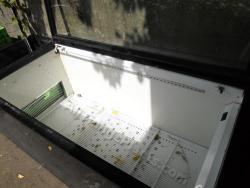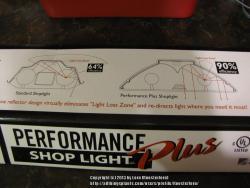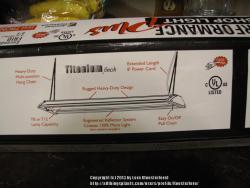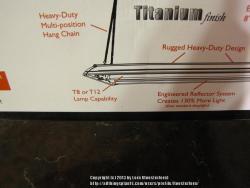Do you really need lights? In general, no. Of course it does depend on the natural light you receive at the season in question. If you live in Seattle (Washington), for instance, where winters are very cloudy and rainy, than certainly, you need supplemental artificial light. But anytime, anywhere, more light than what can be naturally received anywhere inside a house will produce faster growing plants.
Regarding LED lights, the cost will come down drastically in a few years. When CFLs (compact florescent lights) hit the mass market, well after they were first available, Home Depot sold them for $13 for a pack of four. Now, 4-5 years later, they sell for $3. The same (and probably even more drastic) price reduction will occur with LEDs. On top of that, technology is constantly advancing and cheaper will likely also be better quality.

When I think back at how many of those first CFLs were returned to the Home Depot where I work compared to now, the difference is staggering. At this time, LEDs for plants all consist of arrays of a multitude of LED lights. For whatever reason (maybe just poor quality?), people have been experiencing individual LEDs "burning out". (They are likely not actually burning out, but are for whatever reason not working.) Most of the time, these LEDs are not individually replaceable, and you need to replace a whole bank of LEDs. As we all know, right now the initial investment of buying an LED light is huge in comparison to florescent (or incandescent) lighting. It's something each person will need to evaluate for himself, but in my opinion, considering both the future reduction in price and rapid advancement in technology, the economics of it has not met a balancing point. I really don't know anything about how visible colors are produced by LEDs. If it is just the light covering that is filtering out certain light wavelengths (as with incandescent bulbs), then the technology has little, if any, advantage for plants. If the light
emitted from the diode itself is "colored", then a significant advantage could be there.
dellac said:
I was wondering if I could get away with fitting a long tube to the existing wiring,
If by "existing wiring" you mean the refrigerator, that's not a good idea. Run an independent wiring circuit.
T5's or T8's are the same spectrum wise
If I may elaborate, T5s and T8s can be had in a variety of spectrums(spectra?), but in this respect, it makes no difference which type of florescent tube it is.
Are LEDs even appropriate for lilies?
If they work for other "normal" plants, I can't imagine it would be any different for lilies. There is no difference in how light is used by lilies compare to other plants in general
(including marijuana

). That the emerging market is seemingly dominated by pot grower is not surprising to me. They'll do anything if they think it will get them "higher".
They are, after all, stoned.

Lorn, your "off the wall" thought is not that at all. And I hate to burst your bubble, but you're not the first to think of it, although you deserve kudos that you did. Using mirrors, tin foil or even a white board as you describe, or just as sides to somewhat encloses the "chamber" and reflect light back is very beneficial. For plants growing at the edges of the lighted area, you should observe less leaning in toward the main light source. Yes, the spectrum of light reflected is always different from the spectrum of the light source, but never detrimental to my knowledge.
The idea you present of two 3000 lumen florescent tubes being not as bright as one 5000 lumen tube is correct. Let me build on this concept, because it is important to emphasize that "60% as bright" is only true if the two 3000 lumen tubes are working independently. When working in tandem, as they would be in a double tube fixture, any surface in view of both tubes receives light from both tubes. This doesn't translate arithmetically, in other words, any surface does not receive twice the amount of light as it would from single tube, but it is significant. For a double tube fixture, my guess is that the reduction amounts to something closer to 80%, and still with a wider area of coverage.
Think of two imaginary car headlights pointing at you. They are bright. Now imagine how much brighter they seem as the two headlights move closer together (a two bulb fixture), and how much brighter still they are as they merge into one single source of light. Not a perfect analogy, but I think you'll get the idea.
Well now, if you eyes haven't glazed over yet, you're at least ready for bed....

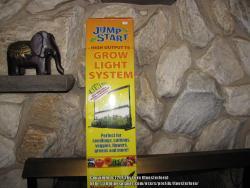
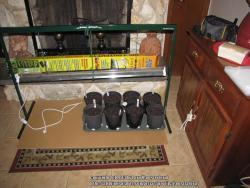
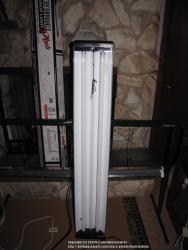 : shop like fixture (less than $20.00 US)
: shop like fixture (less than $20.00 US)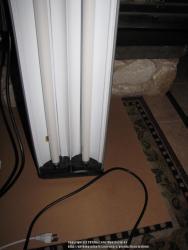 : note double dome reflector
: note double dome reflector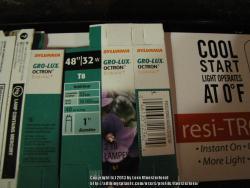 : Sylvania Gro Lux bulbs (about $8.00 each, US
: Sylvania Gro Lux bulbs (about $8.00 each, US 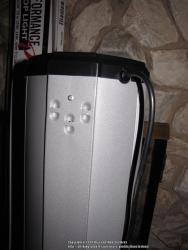 : slots for hooks (usually included)
: slots for hooks (usually included)
